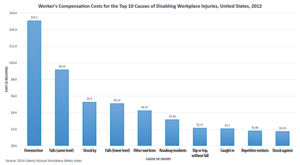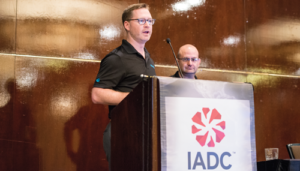HSE&T Corner: Involving employees in JSA development, making corrective actions visible increase buy-in to incident prevention programs
By Kelli Ainsworth, Editorial Coordinator

While the first and most important objective of an incident prevention program is to ensure employees get home safely, a strong program does more than protect people from harm. “They have the benefits of increased productivity, reduced costs and lower employee turnover,” Phil Molé, EHS Expert for Velocity EHS, said on 7 February at the 2017 IADC HSE&T Conference in Houston. “You improve employee morale and job satisfaction overall because you create the kind of environment employees like to be in.”
Employee buy-in is crucial to an effective incident prevention and management program. “Without the buy-in, you don’t really have a good working system.” Companies can get this buy-in by involving employees in the development of the incident prevention process, from the job safety analysis (JSA) to corrective actions, Mr Molé said.
When companies are prioritizing jobs for JSAs, they should first look at the jobs that are associated with the most accidents or injuries. These can be followed by jobs with a high potential for injuries, jobs involving recently modified processes and non-routine jobs. Once all of these jobs have been identified, they should be broken down into individual tasks or steps. “We need to look at each part of the job somebody does to see what exactly is happening in each part so we can identify what hazards there might be,” he said. One of the best ways to ensure that each job task and hazard is accounted for is to involve the employees who perform that job. They can help to identify potential hazards.
The JSAs should be available to all employees, and companies should ensure that employees know where and how to access them, Mr Molé said. “Too often, companies go through the trouble of writing the risk assessments and the JSAs, and they sit on a computer hard drive,” he said. “They are in a folder somewhere, and employees don’t know about them. It defeats the purpose.” Additionally, in the event of an incident, a JSA relating to the job that was being performed when the incident occurred should always be checked. “This is a key step that not enough people do,” Mr Molé added. “If an incident happens, it stands to ask why didn’t your JSA prevent it from happening?”

Velocity EHS recommends investigating and performing root cause analyses on any incident that occurs, big or small. “Being able to identify the near-misses or the close calls as they happen is a very important part of safety because it allows you to correct a hazard before something serious does happen,” Mr Molé said. In order to ensure that employees understand what they’re expected to report, companies should have clear and written procedures and expectations for reporting incidents. The system for reporting incidents should also be clear and straightforward. If the system is too complicated, employees may be less inclined to report an incident or concern.
Once an incident has been reported and investigated, companies need to ensure that each root cause identified in an incident investigation is addressed with a corrective action, said Bill Murphy, Director of Sales at Velocity EHS. Employees who perform a given task or job should be involved in developing corrective actions related to that task or job, he added.
“They’re the ones who know the most about how those tasks are done and the environment they operate in. Getting that buy-in from them to participate will make sure the solutions actually work in practice.”
Ideally, a corrective action should be implemented at the design level, Mr Murphy said. “If we can engineer these challenges out early on, these are going to be the best solutions rather than simply addressing it through a warning or putting up a guard that can be avoided,” he said.
Whatever corrective actions are taken to address a hazard, companies should make sure that employees who reported an incident or concern that led to the corrective action know about it and see that their feedback is valued, Mr Molé said. “One of the main ways you lose employee buy-in is when they bring up an issue or report incidents and they never hear about corrective actions.”
If companies maintain a system that tracks corrective actions and allows employees to see that an issue they reported was addressed, it ensures that they will continue to report incidents or share their concerns with supervisors.
Helping employees reframe their perception of risks can also help to ensure that no incident or concern is overlooked, Mr Molé said. Employees have different perceptions of risk based on their personal history. An employee who has been performing a specific job or task for years without incident might not perceive some of the hazards involved. However, they might be more attuned to the hazards when someone else is performing the job. “They’re going to care whether their co-workers get home safely or not,” he said. “If you can emphasize that, then you can improve their ability to perceive risks and make the workplace safer for everyone.” DC




